- Get Started
- Centers
- Administrative Coordinating Center (ACC)
- Informatics Research Center (IRC)
- NIH
- Omics Centers
- Baylor Human Genome Sequencing Center
- Baylor-UTHealth Metabolomics Center
- Broad Institute Genomics Platform
- Broad Institute Metabolomics Platform
- Broad Institute and Beth Israel Proteomics Platform
- Illumina
- Keck MGC
- New York Genome Center Genomics
- Northwest Genomics Center
- New York Genome Center RNA-seq
- Psomagen
- Projects/Studies
- Working Groups
- Data
- Publications
- EEP
- ELSI
- Workshops
Redline - Cleveland Family Study-WGS Collaboration (CFS)
Updated 10/19/2017
Introductory slides from the June 4, 2015 Steering Committee/EAP meeting (requires log-in).
Obstructive Sleep Apnea (OSA) affects more than 10% of the population, especially minorities, and is associated with significant cardio-metabolic morbidity. We propose using data from the Cleveland Family Study (CFS), a genetic epidemiological study of OSA, as well as data from cohorts studied as part of our collaborations with other NHLBI cohorts to enhance the identification of genes that increase susceptibility to OSA, with a focus on those variants that increase susceptibility in African Americans.
The CFS is a genetic epidemiological study of 352 rigorously phenotyped families ascertained through probands with OSA identified through Cleveland, OH area sleep centers, neighborhood controls, and the spouses and first and second degree relatives of probands. Participants were studied on up to 4 exams between 1990-2006 with overnight sleep studies, standardized anthropometry; questionnaires; blood pressure; and spirometry. Fasting serum and ECGs are available from the last exam. Participants have a mean age of 37.7 years (African Americans) and 41.4 years (European Americans). Slightly more than 50% of the sample is female and 31% have moderate to severe OSA; 12.6% have diabetes, and 34.0% have hypertension. Asthma is reported in 19% and 13% of the African Americans and European Americans, respectively. Heritability analysis of traditional OSA traits as well as novel traits such as hypopnea duration (a marker of respiratory arousability) as well as overnight oxygenation (a marker of susceptibility to hypoxemia occurring with recurrent apneas) has shown that the latter traits are more heritable (h2 > 0.50) than traditional measures. Linkage analysis has identified peaks (and individual families contributing to peaks) for these traits. Through the Life After Linkage initiative (5R01HL113338), we further have aggregated and analyzed data on 19,798 individuals from 7 cohorts (Cleveland Family Study [CFS] plus ARIC, FHS, HCHS/SOL, MESA, MrOS, and Starr County) and conducted the largest GWAS to date of OSA traits.
We proposes to use WGS and highly sophisticated statistical tools to completely characterize the genetic variation in richly phenotyped multi-ethnic populations and in families enriched for OSA as well as CVD and pulmonary traits. We aim to more completely and definitively characterize the allelic spectrum of functional genetic variation associated with OSA, as well as to contribute to consortia-wide activities to identify causal variation for other HLB phenotypes. We propose to conduct WGS in 1000 Cleveland Family Study family as well as to collaborate with other WGS consortium members (e.g., Jackson Heart Study) where sleep phenotyping is available. Complete characterization of genetic variation with WGS will allow for direct interrogation of causal functional variation irrespective of whether it is coding or regulatory; common, rare, private or de novo, thus improving upon data from exome sequencing. We will apply existing and newly developed analytical tools for detecting associations informed by linkage, and for conducting gene-based tests, bioinformatics pathway analyses, fine-mapping of GWAS and linkage signals using functional annotation, cross-phenotype analyses, and heritability partitioning to identify causal variants and reveal the allelic architecture of OSA, facilitating the discovery of physiological pathways. More comprehensive sequencing data, including a complete catalogue of genetic variation in each sequenced participant, will improve the ability to identify important inherited and de novo functional coding and regulatory variants outside of exomic regions for OSA, fine-map GWAS and linkage signals as well as will contribute to the discovery and fine-mapping of variants for a broad range of CVD, blood and pulmonary phenotypes collected in these cohorts. We will focus on the major metrics that characterize OSA such as the Apnea Hypopnea Index, as well as highly heritable traits that provide information on physiological mechanisms underlying OSA such as hypopnea duration as well as overnight oxygenation.
More information can be viewed at https://sleepdata.org/

